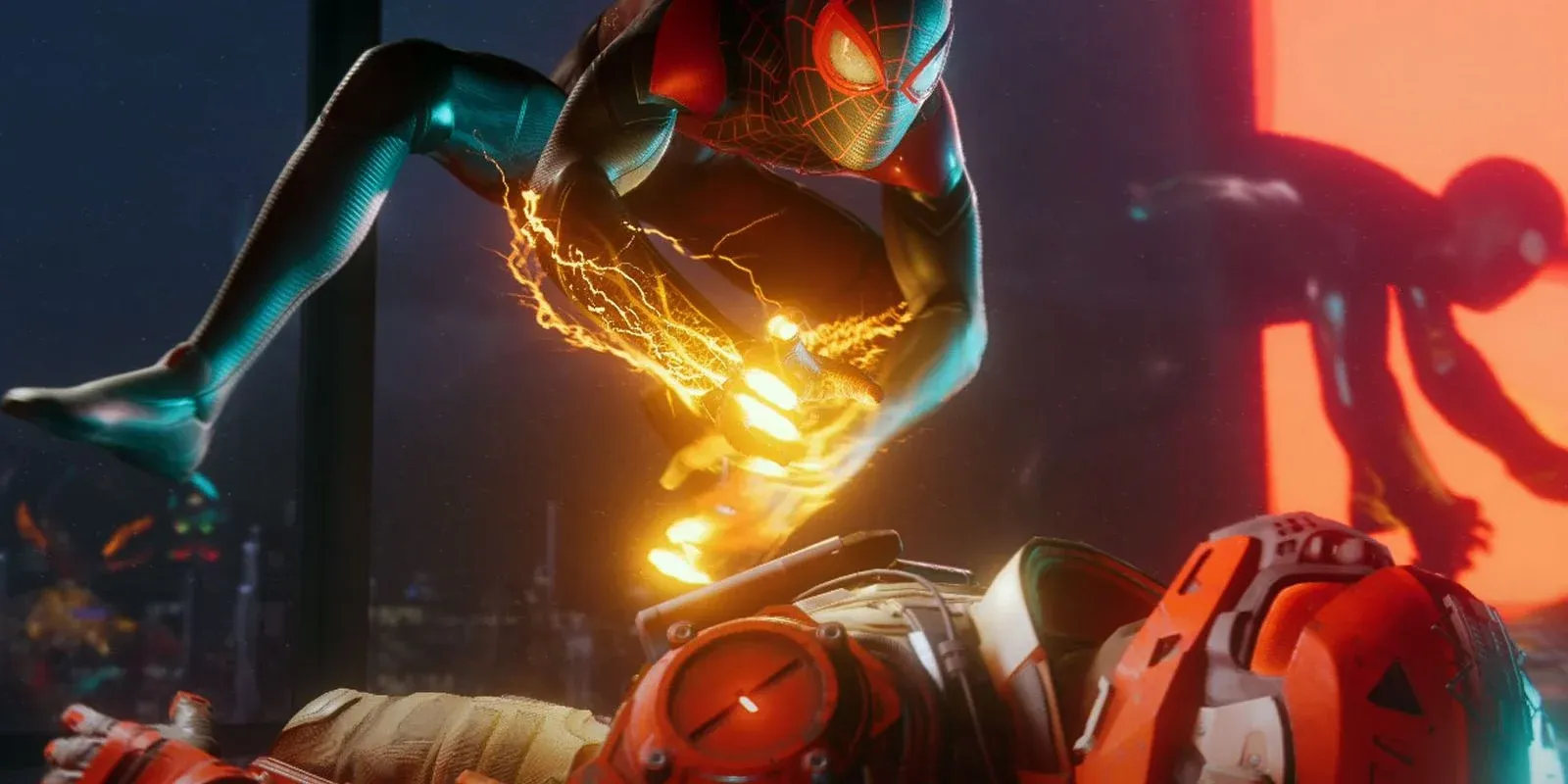This Spider-Man Villain Lives Among Us
Spider-Man: Miles Morales explores environmental racism and its impact

New York City shines with its brightly colored ads and not one, but two Spider-Men. As Miles Morales finds his place as a hero, a new enemy steps onto the scene. It’s an enemy that can turn your community into an unlivable space, destroy your health, shave years off your life.
The name of this enemy is Roxxon Energy.
If you’re a fan of the Marvel universe, you know Roxxon is bad news. This multinational gas and oil company continues to crawl back into the comic book pages, shows, and now in games as an unbeatable enemy.
While Roxxon is a thing of fiction, I found it represented an actual threat that lives among us. It represented the thousands of companies and harmful practices today that continue to affect the health of millions, specifically communities of color. It’s an enemy that even Spider-Man can’t beat. Not alone, at least.
What is Environmental Racism?
Toxic soil. Unclean water. Exposure to higher levels of pollution. These are but a few from a long list of environmental hazards that disproportionately affect Black, Indigenous, Latino, and other communities of color. While low-income communities are also significantly affected, an assessment conducted by the Environmental Protection Agency in 2018 found that non-white Americans “are subjected to higher levels of air pollution than white Americans — regardless of their income level.” There is an undeniable relationship between these hazards and race.
Power stations, gas pipelines, disproportionate harm after a natural disaster, major highways, and more are not affecting these communities by coincidence. They exist through oppressive policies and practices that target and affect individuals and communities of color.
“Environmental racism is particularly insidious because …it is hidden away in government siting and permitting decisions, or the lack of representation as governments make decisions about who will bear the brunt of pollution.” — Mary Ashanti
These environmental hazards negatively affect the quality of life of those who live around them. Exposure to high levels of pollution over years has led to communities developing cancer, asthma, heart disease, birth defects, and increased risk of a severe reaction to COVID-19.
Environmental injustices takes shape in different forms
In Louisiana, an 85 mile stretch of oil refineries and petrochemical plants has been killing communities of color and low-income communities since the 1980s. Residents have dubbed it “Cancer Alley”: the risk of developing cancer is 50 times the national average if you live there.
Flint, Michigan — seven years after the Flint Water Crisis — is still struggling to replace its pipes to provide clean water to its city.
In West Harlem a wastewater facility filled the residential neighborhood nearby with hazardous fumes in 2000, earning the nickname “sewage chernobyl.”
Another aspect of environmental racism is how climate change affects different communities. For example, when Hurricane Katrina struck New Orleans in 2005, it wasn’t just the extreme weather that snuffed out lives. Lives were lost partly because of inequality and racism. The communities who faced the brunt of the damage were mostly black communities thanks to the local government failing to maintain the levees in these areas. And when the storm left, it was white and wealthier communities who bounced back.
Environmental racism thrives off of systems and practices set in place that operates to maintain inequality. The above are just snapshots (in no way a comprehensive view) of the systematic environmental injustices that stretches all over the nation, harming the communities it touches.

The Roxxon Threat
Roxxon has always been present in the Spider-Man games, usually as an advertisement or a logo splashed across a gas station. Now, Roxxon takes form in the shape of underground labs and heavily armed security who will protect Roxxon’s investments.
Roxxon has recently developed Nuform, a source of “clean energy” that will revolutionize New York City. One canister of Nuform promises to power each neighborhood with “clean, safe energy for the next 500 years.” You will find Nuform reactors scattered across the city, most tucked away underground save for the one in Roxxon’s new facility in Harlem.

Despite the cheery promise of what Nuform can promise, the game immediately sets the tone that Roxxon is a company that cares less about people and more about profits.
At a rally held by Rio Morales (Miles’ mother), she shares to both the community and local news the incredible loss the Harlem community faced when Roxxon moved in. They displaced shops and livelihoods to make room for Roxxon Plaza. She further calls for transparency from Roxxon on Nuform’s side effects.
It’s a much-needed call. The developer of Nuform, Rick Mason, discovered that when exposed to Nuform for an extended period, it can lead to severe illness.
We can see the impact of Nuform through video logs recorded by Rick and his sister, Phin. While the extent of his illness is unknown, we see him becoming more sickly in appearance over time, taking fluids via an IV drip. Even Roxxon’s guards stationed in underground facilities will express fear over Nuform’s impact on their health.
The game becomes a painful tale of the incredible lengths Roxxon leadership will go to make sure this information doesn’t reach the public.

The Significance of Harlem
Harlem is a vibrant neighborhood bursting with life, diversity, and creativity. People from all walks of life, with whom Miles can engage and build relationships, live in this neighborhood.
In previous games, there is a professional distance between Peter and the city. Beyond the high-fives from a passerby and the social media interaction, Peter’s connections and his stories are confined to Aunt May and Mary Jane.
In Spider-Man: Miles Morales, we see the relationship between New York’s new hero and his community in an authentic way. This isn’t just Miles’ story we are witnessing. It’s the bodega owner and his cat, the street artists, his mom’s campaign for a city council seat — it’s the collective stories within his neighborhood. We watch Miles embrace and love his community.
It’s, also, a community that has been fighting for more than a hundred years to be heard.
This is the neighborhood that housed the Harlem Renaissance movement, where great minds and artists created and used their creativity to present a realistic presentation of what it means to be black. Harlem was ground zero in the long struggle for racial equality in America and the constant fight against gentrification. The Harlem community’s fight for fairness and representation has been a long and enduring one.
So it is no coincidence that Roxxon is staging the launch of their Nuform product in Harlem. Harlem — a neighborhood where 77% of its residents are people of color — has faced the brunt of poor policies and corporations digging their fingers into the community, but not without a fight.
Harlem residents continue to go toe-to-toe with corporations and local government. In 1982, residents protested the location of toxic landfills, leading to the arrest of 523 protestors. In 1988, the West Harlem Environmental Action (now called WE ACT for Environmental Justice) was founded to oppose the city’s poor policies that strove to further pollute the community.
While there have been wins in this fight, environmental hazards continue to impact and seep into the neighborhood. In 2013, Harlem was voted the most toxic neighborhood. With a “six-lane highway, an exposed high-speed rail line, and a dysfunctional sewage treatment plant through which almost half of Manhattan’s sewage flows”, one can see why.
It’s why seeing Rio Morales and Harlem residents continue to raise their voices and advocate on screen, despite the cold shoulder from local government, is important. This is not a fight that started when Roxxon moved in. It’s a fight that has been taking place for ages outside your console and TV screen. It’s been a constant fight by Harlem and other communities nationwide to protect their home and lives.

The Price
Advocacy, rallies, protesting, and educating the public are not enough to silence Roxxon. Rio Morales hits a brick wall in her campaign for transparency and to reclaim the space lost by Roxxon. With her running for City Council, she hopes to return power back to Harlem and other communities that have been silenced (although I wish the game shared her position on other topics besides Roxxon).
Roxxon isn’t the only corrupt entity lurking about. Even from within prison, Wilson Fisk has been coordinating efforts via City Hall to shut down the F.E.A.S.T. (Food, Emergency, Aid, Shelter, and Training) homeless shelter so he can control the property for his own personal gain.
This is where Spider-Man becomes a monumental force of good for the community. Miles uses his gifts to expose corruption and pass the information to the correct parties. He’s not the only one. Phin Mason (sister of Rick Mason, developer of Nuform) has been using her own skills and tools to confront Roxxon.
Their methods of facing Roxxon vastly differ, but they’re both methods that stem from the inability and reluctance of government leadership to protect these targeted communities.
What’s frustrating is that Phin and Miles have to continue to sacrifice themselves to stop Roxxon.
For Miles to make Nuform reactors unusable, he has to take in its energy. Holding it within his body is physically agonizing and can kill him if held for too long. He has to find a safe place to release the energy to prevent others from becoming injured.

While Miles appears to recover each time, I can’t help but wonder what is the long-term impact on his body. Will his newfound abilities stop the permanent wear and tear we see in Roxxon’s guards and in Rick Mason? That’s unclear, but it’s a reality for thousands who live around toxic sites and highly polluted areas.
For Phin, the sister of Rick Mason, hers is a story of finding justice for her brother through any means possible. While her methods are extreme, we can’t forget what brought her to fight Roxxon. She not only watched her brother wither away from Nuform exposure, but she also watched Krieger claim the creation as his and later watched Roxxon impassively take his life before her eyes.
Roxxon is even willing to sacrifice one of its reactors to stop an organization (The Underground) because they’re threatening the company’s bottom line. The price of sacrificing this reactor means wiping Harlem off the map. Literally. Buildings, homes, shops, and lives will be lost to the deadly explosion.
Miles is placed in a position where he has to absorb the energy from the unstable reactor to prevent further damage. With nowhere to safely diffuse the energy, the risk of harming Harlem’s residents is very real.
It’s Phin who will take him far from Harlem’s residents, understanding that this will mean she’s the only one caught in the crossfire. In a moment of cruel irony, Phin will lose her life to Roxxon’s products, just like her brother.

Final Thoughts
It’s impossible to say there is justice or accountability when the game credits roll.
Harlem, Phin, and Rick Mason suffered and lost their lives. Even with Krieger being sent to prison, Roxxon will continue to grow without him. It will continue to endorse and take advantage of harmful practices and policies that negatively impact others. Environmental injustices will continue and target communities like Harlem.
I wish the game took it a step further to acknowledge that much of the tragedy that took place could have been prevented if politicians did not favor big corporations over the well-being of local communities. Or that environmental injustices are rampant and systematic.
I have to remember that the game is really about watching Miles grow into a hero and I cannot wait to see more of him in future games. However, that doesn’t mean this issue shouldn’t be explored in future installments and outside of the Spider-Man franchise.
Yes, the city needs Spider-Man, but what we need more is an end to this system of inequality. That’ll take more than Spider-Man — even two Spider-Mans — to accomplish. It’ll take education, advocacy, drastic change to current policies, and constant pressure on leadership.
